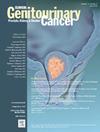主动监测是双侧多灶性肾嗜瘤细胞瘤的合适方法吗?20年的国家癌症研究所经验。
IF 2.7
3区 医学
Q3 ONCOLOGY
引用次数: 0
摘要
目的:探讨主动监测和/或手术治疗双侧多灶肾嗜瘤细胞瘤患者的临床特征、肿瘤生长速度、肿瘤和肾功能结局。材料和方法:对双侧、多灶性肾嗜瘤患者进行临床、横断面成像和病理记录评估。该队列分为3组:仅接受主动监测组、接受手术联合主动监测组和接受多种干预组。比较三组患者的生长速度、转移情况及肾功能结局。结果:62例患者(中位年龄64岁(IQR 57.5-69), 49例男性),其中10例(16.1%)有双侧多灶性嗜酸细胞瘤家族史。总体而言,三组原发性肿瘤的合并中位生长速率为0.25 cm/年(IQR 0.1-0.4)。三组患者的诊断年龄差异有统计学意义(P = 0.01),而死亡年龄差异无统计学意义。未见远处转移。三组患者末次随访时中位肿瘤大小差异有统计学意义(P = 0.02)。三组间肿瘤原发生长率(P = 0.50)、初始eGFR (P = 0.35)、最终eGFR (P = 0.26)及eGFR随时间变化(P = 0.10)差异均无统计学意义。结论:在接受主动监测和/或手术治疗的患者中,疾病特异性结局和肾功能结局没有显著差异。本文章由计算机程序翻译,如有差异,请以英文原文为准。
Is Active Surveillance a Suitable Approach for Bilateral Multifocal Renal Oncocytomas? The 20-Year National Cancer Institute Experience
Objectives
To investigate the clinical characteristics, tumor growth rate, oncologic and renal function outcomes in patients with bilateral, multifocal renal oncocytoma managed with active surveillance and/or surgery.
Materials and Methods
Bilateral, multifocal renal oncocytoma patients were evaluated using clinical, cross-sectional imaging and pathologic records. The cohort was divided into 3 groups: those under active surveillance only, those who underwent surgery in combination with active surveillance, and those who underwent multiple interventions. Growth rate, metastases and renal function outcomes were compared between the 3 groups.
Results
Sixty-two patients (median age 64 years (IQR 57.5-69), 49 men) were identified with 10 patients (16.1%) having a known family history of bilateral, multifocal oncocytoma. Overall, the combined median growth rate of primary tumors across all 3 groups was 0.25 cm/year (IQR 0.1-0.4). Comparing between all 3 groups identified a statistically significant difference in age of diagnosis (P = .01), whereas no difference was noted for age at death. No distant metastasis was observed. A statistically significant difference in median tumor size at the time of last follow-up (P = .02) was reported among the 3 groups. No statistically significant differences were seen in primary tumor growth rate (P = .50), initial eGFR (P = .35), final eGFR (P = .26) and change in eGFR levels over time (P = .10) among all 3 groups.
Conclusion
Disease-specific outcomes and renal function outcomes do not differ significantly among the patients managed with active surveillance and/or surgery.
求助全文
通过发布文献求助,成功后即可免费获取论文全文。
去求助
来源期刊

Clinical genitourinary cancer
医学-泌尿学与肾脏学
CiteScore
5.20
自引率
6.20%
发文量
201
审稿时长
54 days
期刊介绍:
Clinical Genitourinary Cancer is a peer-reviewed journal that publishes original articles describing various aspects of clinical and translational research in genitourinary cancers. Clinical Genitourinary Cancer is devoted to articles on detection, diagnosis, prevention, and treatment of genitourinary cancers. The main emphasis is on recent scientific developments in all areas related to genitourinary malignancies. Specific areas of interest include clinical research and mechanistic approaches; drug sensitivity and resistance; gene and antisense therapy; pathology, markers, and prognostic indicators; chemoprevention strategies; multimodality therapy; and integration of various approaches.
 求助内容:
求助内容: 应助结果提醒方式:
应助结果提醒方式:


